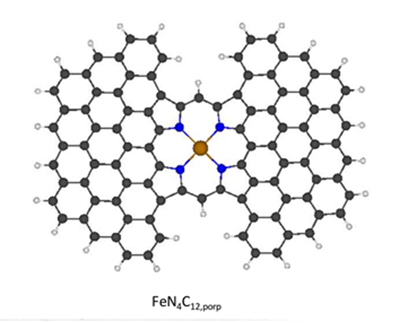With energetic transition being at stake, the oxygen reduction reaction (ORR) has become paramount in the behavior of polymer electrolyte membrane fuel cells, which use H2 as a vector of energy and could power our future cars. Scientists from SOLEIL, closely working with a team from the Charles Gerhardt Institute of Montpellier (UMR 5253/Université de Montpellier), identified the structure of potentials new active site for the catalysis of this reaction.
For several years, Me-N-C catalysts have been investigated in order to replace platinum, which is the most-effective known catalyst of the ORR but whom natural reserves are not infinite. Iron being one of the metals currently considered, a number of FeNxCy have recently been proposed as potential catalysts of this reaction. Until now, the structure of the active site has remained elusive.
Employing X-rays absorption spectroscopy at the SAMBA beamline, the scientific team studied the structure of active sites in iron-based catalysts. A high temperature pyrolysis has been used to prepare a catalyst from precursors containing iron, azote and carbon. At the end, scientists obtained graphene sheets in which iron atoms are scattered but coordinated by azotic atoms doping the carbon suppor. The method developed for this synthesis makes it able to avoid the formation of crystallographic iron structures and then allows the structural investigation of the catalysts.
The four catalysts have then been analyzed using EXAFS spectroscopy[1] (for Extended X ray Absorption Fine Structure). Lengths of the several bonds were measured but this technique did not give information regarding the coordination number nor the structural configuration of the active site. To go further, the XANES spectroscopy[2] (X-ray Absorption Near-Edge Spectroscopy), more sensitive to the atoms’ arrangement, has been used. Theoretical modeling of the XANES spectra led to the conclusion that the studied structure was in fact a FeN4C12 moiety, then revealing the existence of a catalytic site based on a porphyrinic architecture. In this configuration, the FeN4 active site could act as a bond between two graphene sheets. This conclusion invalidates the pyrinidic structure that was considered so far.

Figure: Porphyrinic’s architecture of the active site
Scientists then investigate, still using the XANES spectroscopy, the catalysts’ ability to bond to dioxygen. They were able to identify two structures fitting with the experimental spectra they observed. This result, confirmed by Mossbauer spectroscopy, demonstrates the existence of two main types of active sites.
This study represents a breakthrough in the understanding of those active sites’ structure and will be of fundamental importance to understand future in operando studies. It also paves the route for the use of XANES for a structural investigation of graphene-based Me-N-C catalysts in fuel cells.
[1] In this technique, the sample is enlightened by an X-ray beam with variable energy. When the radiation corresponds to the transition energy of an electron, an absorption threshold is reached. This results in the ejection of an electron. This technique provides information on the atomic environment of the test compound.
[2] Usually paired with the EXAFS technique, this method of spectroscopic analysis gives more accurate information on the atomic environment and on the oxidation state of the test compound. As EXAFS, it is based on the excitation by a photon of an electron’s heart level to free electron levels. It differs from the EXAFS by the energy scale considered around the absorption edge. This is why we also refer to this technique as NEXAFS spectroscopy (for Near Edge X - ray Absorption Fine Structure).
